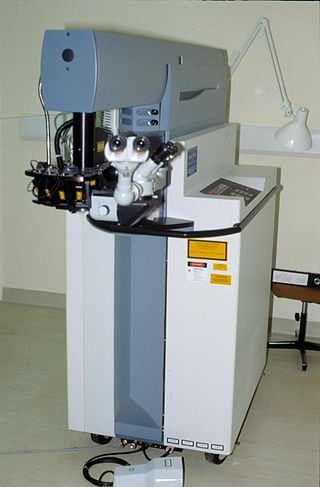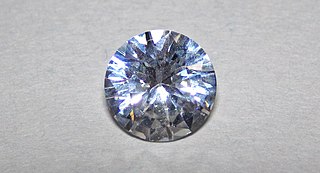
A laser is a device that emits light through a process of optical amplification based on the stimulated emission of electromagnetic radiation. The word laser is an anacronym that originated as an acronym for light amplification by stimulated emission of radiation. The first laser was built in 1960 by Theodore Maiman at Hughes Research Laboratories, based on theoretical work by Charles H. Townes and Arthur Leonard Schawlow.

A laser diode is a semiconductor device similar to a light-emitting diode in which a diode pumped directly with electrical current can create lasing conditions at the diode's junction.
Q-switching, sometimes known as giant pulse formation or Q-spoiling, is a technique by which a laser can be made to produce a pulsed output beam. The technique allows the production of light pulses with extremely high (gigawatt) peak power, much higher than would be produced by the same laser if it were operating in a continuous wave mode. Compared to modelocking, another technique for pulse generation with lasers, Q-switching leads to much lower pulse repetition rates, much higher pulse energies, and much longer pulse durations. The two techniques are sometimes applied together.

The vertical-cavity surface-emitting laser, or VCSEL, is a type of semiconductor laser diode with laser beam emission perpendicular from the top surface, contrary to conventional edge-emitting semiconductor lasers which emit from surfaces formed by cleaving the individual chip out of a wafer. VCSELs are used in various laser products, including computer mice, fiber optic communications, laser printers, Face ID, and smartglasses.

An excimer laser, sometimes more correctly called an exciplex laser, is a form of ultraviolet laser which is commonly used in the production of microelectronic devices, semiconductor based integrated circuits or "chips", eye surgery, and micromachining. Since 1960s excimer lasers are widely used in high-resolution photolithography machines, one of the critical technologies required for microelectronic chip manufacturing.
A diode-pumped solid-state laser (DPSSL) is a solid-state laser made by pumping a solid gain medium, for example, a ruby or a neodymium-doped YAG crystal, with a laser diode.

Yttrium aluminium garnet (YAG, Y3Al5O12) is a synthetic crystalline material of the garnet group. It is a cubic yttrium aluminium oxide phase, with other examples being YAlO3 (YAP) in a hexagonal or an orthorhombic, perovskite-like form, and the monoclinic Y4Al2O9 (YAM).

A solid-state laser is a laser that uses a gain medium that is a solid, rather than a liquid as in dye lasers or a gas as in gas lasers. Semiconductor-based lasers are also in the solid state, but are generally considered as a separate class from solid-state lasers, called laser diodes.

Laser pumping is the act of energy transfer from an external source into the gain medium of a laser. The energy is absorbed in the medium, producing excited states in its atoms. When for a period of time the number of particles in one excited state exceeds the number of particles in the ground state or a less-excited state, population inversion is achieved. In this condition, the mechanism of stimulated emission can take place and the medium can act as a laser or an optical amplifier. The pump power must be higher than the lasing threshold of the laser.
Amplified spontaneous emission (ASE) or superluminescence is light, produced by spontaneous emission, that has been optically amplified by the process of stimulated emission in a gain medium. It is inherent in the field of random lasers.
Ultrafast laser spectroscopy is a spectroscopic technique that uses ultrashort pulse lasers for the study of dynamics on extremely short time scales. Different methods are used to examine the dynamics of charge carriers, atoms, and molecules. Many different procedures have been developed spanning different time scales and photon energy ranges; some common methods are listed below.

A ruby laser is a solid-state laser that uses a synthetic ruby crystal as its gain medium. The first working laser was a ruby laser made by Theodore H. "Ted" Maiman at Hughes Research Laboratories on May 16, 1960.
Neodymium-doped yttrium lithium fluoride (Nd:YLF) is a lasing medium for arc lamp-pumped and diode-pumped solid-state lasers. The YLF crystal (LiYF4) is naturally birefringent, and commonly used laser transitions occur at 1047 nm and 1053 nm.

A disk laser or active mirror (Fig.1) is a type of diode pumped solid-state laser characterized by a heat sink and laser output that are realized on opposite sides of a thin layer of active gain medium. Despite their name, disk lasers do not have to be circular; other shapes have also been tried. The thickness of the disk is considerably smaller than the laser beam diameter. Initially, this laser cavity configuration had been proposed and realized experimentally for thin slice semiconductor lasers.
Self-pulsation is a transient phenomenon in continuous-wave lasers. Self-pulsation takes place at the beginning of laser action. As the pump is switched on, the gain in the active medium rises and exceeds the steady-state value. The number of photons in the cavity increases, depleting the gain below the steady-state value, and so on. The laser pulsates; the output power at the peaks can be orders of magnitude larger than that between pulses. After several strong peaks, the amplitude of pulsation reduces, and the system behaves as a linear oscillator with damping. Then the pulsation decays; this is the beginning of the continuous-wave operation.
EKSPLA is a laser manufacturing company based in Lithuania. EKSPLA is known for their lasers and laser systems, as well as other photonics components. The company is supplying their products for scientific, OEM & industrial applications.

The Extreme Light Infrastructure is a research infrastructure with the world's largest collection of high power-lasers. ELI consists several high-power, high-repetition-rate laser systems which enable the research of physical, chemical, materials, and medical sciences.
Central Laser Facility (CLF) is a research facility in the UK. It is part of the Rutherford Appleton Laboratory. The facility is dedicated to studying the applications of high energy lasers. It was opened in 1976. As of 2013 there are 5 active laser laboratories at the CLF: Vulcan, Astra Gemini, Artemis, ULTRA, and OCTOPUS. The facility provides both high-power and high-sensitivity lasers for study across broad fields of science from atomic and plasma physics to medical diagnostics, biochemistry and environmental science. Also through the Centre for Advanced Laser Technology and Application (CALTA), CLF is responsible for laser development. DiPOLE is the brainchild of that project.

Lightwave Electronics Corporation was a developer and manufacturer of diode-pumped solid-state lasers, and was a significant contributor to the creation and maturation of this technology. Lightwave Electronics was a technology-focused company, with diverse markets, including science and micromachining. Inventors employed by Lightwave Electronics received 51 US patents, and Lightwave Electronics products were referenced by non-affiliated inventors in 91 US patents.
Semiconductor saturable-absorber mirrors (SESAMs) are a type of saturable absorber used in mode locking lasers.










